状语的具体讲解(二)时间状语
(完整版)状语从句的讲解最全的状语从句讲解

状语从句的讲解就是用一句话作状语分为:时间,地点,方式,原因,结果,条件,让步,目的,比较一、时间状语从句第一次见到你一见到你我就喜欢上了你直到见到你五岁时见到你When, as, while, before, after, since, till/until, as soon as no sooner…than…scarcely…when…hardly…when… the minute the second the instant the moment by the time 截止 immediately instantly directlyeach time every time next time the first time on doing sthwhenwhile 当…时as1。
when 1)当…时/ 延续性动词短暂性动词都可用2)这时/3)届时、到时I was watching TV when my cellphone suddenly rang这时When I was five years old I could speak five languagesThe wet weather will continue tommorow when a cold front is expected to arrive届时到时注意:时间状语从句中动作发生有前后时先发生的用过去完成时When my mother came back I had already gone to bed.2。
while 1)从句动词延续性2)同时发生3)对比的意味“然而”4)趁着He taught himself while he worked in a bank 延续性动词当他在银行上班时While we were working they were having a rest.对比While they were having a discussion , they got very confused。
状语从句全类型讲解教案

状语从句全类型讲解教案一、引言。
状语从句是复合句的一种,用来修饰主句,表示时间、原因、条件、让步、目的等不同的关系。
状语从句的类型有很多,包括时间状语从句、原因状语从句、条件状语从句、让步状语从句、目的状语从句等。
掌握状语从句的不同类型对于提高写作和阅读能力非常重要。
本教案将全面讲解状语从句的各种类型,帮助学生更好地掌握状语从句的用法。
二、时间状语从句。
时间状语从句用来表示主句发生的时间,常见的引导词有when, while, as, before, after, since, until等。
例如:When I was young, I used to play basketball every day.After she finished her homework, she went to bed.时间状语从句表示的时间可以是过去、现在或将来,根据主句的时态来确定。
需要注意的是,如果主句是一般现在时,时间状语从句通常使用一般过去时表示过去的动作或状态;如果主句是一般过去时,时间状语从句通常使用过去完成时表示更早的过去。
三、原因状语从句。
原因状语从句用来表示主句发生的原因,常见的引导词有because, since, as, for, now that等。
例如:Because it was raining, we stayed at home.Since she was tired, she went to bed early.原因状语从句表示的原因可以是客观原因或主观原因,需要根据具体语境来确定。
需要注意的是,原因状语从句通常放在主句之前,用逗号隔开时则可以放在主句之后。
四、条件状语从句。
条件状语从句用来表示主句发生的条件,常见的引导词有if, unless, provided that, on condition that等。
例如:If it rains tomorrow, we will stay at home.Provided that you finish your homework, you can go outto play.条件状语从句表示的条件可以是真实的、非真实的或虚拟的,需要根据具体语境来确定。
高中英语状语从句讲解与练习

高中英语状语从句讲解与练习高中英语状语从句一、时间状语从句1、when的用法(1)when既可引导一个持续性动作,也可引导一个短暂性动作,可用于表示主句和从句动作同时发生或从句动作先于主句动作,有时还可表示从句动作后于主句,意为“当……时候”。
(2)when在beabouttodo……when……,bedoing……when……,haddone……when……,beonone’sway……when……,beonthepointofdoing…when……等结构中作“那时突然”讲。
(3)when“既然、鉴于;尽管,虽然(位于主句之后);如果”2、while的用法(1)则表示“当……时候”,鼓励的动作必须就是延续性的。
(2)用做同列连词,则表示相对关系“然而”。
(3)引导让步状语从句,相当于although,意为“虽然”,位于主句前。
(4)引导条件状语从句,相当于as/solongas,意为“只要”。
3、as的用法(1)则表示“当……时候”,特别强调同时出现,不所指先后。
(2)说明两种正在发展或变化的情况,表示“随着”,表示时间的推移。
(3)表示“一边……一边……”(4)强调两个动作紧接着发生。
(5)表示“虽然,尽管”(6)其他含义“正像,正如”,“做为”,“由于,因为”。
4、before的用法(1)一般意为“在……之前”“……才”,“……就”“还没有……”“免得”“不知不觉”“宁可,宁愿”,“否则,要不然”。
(2)itwillbe/was时间段before通常现在时/通常过去时。
在肯定句中,意为“多长时间之后才”;在否定句中,意为“用没法多长时间就”。
5、until和till(1)与肯定句连用,必须是延续性动词。
(2)与否定句属格,必须不为延续性动词,则表示“直至……才,在……之前不……”。
特别注意:notuntil可以用作特别强调句和倒装句强调句:itis/wasnotuntil…that…倒装句:notuntil放句首时,主句要部分倒装。
高中英语语法时间状语从句讲解
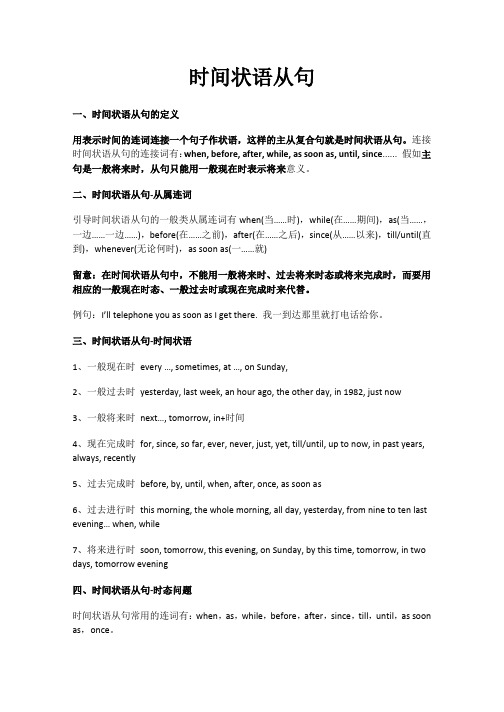
时间状语从句一、时间状语从句的定义用表示时间的连词连接一个句子作状语,这样的主从复合句就是时间状语从句。
连接时间状语从句的连接词有:when, before, after, while, as soon as, until, since...... 假如主句是一般将来时,从句只能用一般现在时表示将来意义。
二、时间状语从句-从属连词引导时间状语从句的一般类从属连词有when(当……时),while(在……期间),as(当……,一边……一边……),before(在……之前),after(在……之后),since(从……以来),till/until(直到),whenever(无论何时),as soon as(一……就)留意:在时间状语从句中,不能用一般将来时、过去将来时态或将来完成时,而要用相应的一般现在时态、一般过去时或现在完成时来代替。
例句:I’ll telephone you as soon as I get there. 我一到达那里就打电话给你。
三、时间状语从句-时间状语1、一般现在时every …, sometimes, at …, on Sunday,2、一般过去时yesterday, last week, an hour ago, the other day, in 1982, just now3、一般将来时next…, tomorrow, in+时间4、现在完成时for, since, so far, ever, never, just, yet, till/until, up to now, in past years, always, recently5、过去完成时before, by, until, when, after, once, as soon as6、过去进行时this morning, the whole morning, all day, yesterday, from nine to ten last evening… when, while7、将来进行时soon, tomorrow, this evening, on Sunday, by this time, tomorrow, in two days, tomorrow evening四、时间状语从句-时态问题时间状语从句常用的连词有:when,as,while,before,after,since,till,until,as soon as,once。
状语从句知识点详解(初中英语专项复习)14

状语从句知识点详解(初中英语专项复习)状语从句的概念: 用一个句子作状语来修饰动词和形容词,以表明动作发生或状态存在的时间、地点、原因等,这个句子就叫做状语从句。
状语从句的分类:状语从句共分为九大类,包括:时间、地点、原因、条件、让步、目的、结果、方式、比较状语从句。
下面分别讲解:一、时间状语从句概念:用来表示时间的状语从句,由when, while, as, till, until,before, after, since等引导。
由于时间状语从句的引导词所表示的意思并非一致,不同引导词表达不同的时间,它们在句子中对应的时态、语态等也有所不同。
例如:when /while引导的时间状语从句when引导的从句的谓语动词通常是瞬间动词,也可以是延续性动词。
从句动作可与主语动作通常先后发生也可同时发生。
I was writing when my sister came back.( come是瞬间动词,只能用when引导,不能用while)He often wrote me when/while he studied in Shanghai International Studies University.( study 是延续性动词,while可代替when)While my mother was cooking , I was playing chess with dad. (cook是延续性的动词,cook和play同时发生)I like playing chess while my sister likes reading stories.我喜欢下棋,而我姐姐喜欢看小说。
(while表示对比)when和while的区别还有:while引导的时间状语从句多用于进行时态,而when引导的时间状语从句多用于一般时态。
While we were playing games, our headmaster called me .我们正在做游戏的时候,校长叫我了。
时间状语从句详细讲解与练习
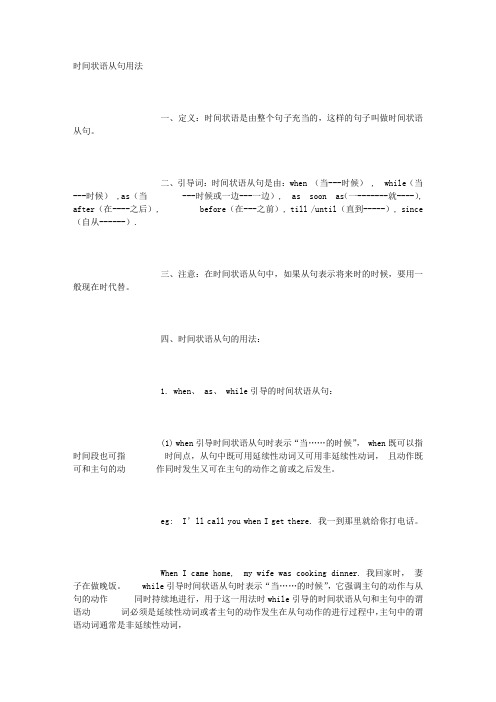
时间状语从句用法一、定义:时间状语是由整个句子充当的,这样的句子叫做时间状语从句。
二、引导词:时间状语从句是由:when (当---时候) , while(当---时候) ,as (当---时候或一边---一边) , as soon as(一-------就----), after(在----之后), before(在---之前), till /until(直到-----), since(自从------).三、注意:在时间状语从句中,如果从句表示将来时的时候,要用一般现在时代替。
四、时间状语从句的用法:1. when、 as、 while引导的时间状语从句:(1) when引导时间状语从句时表示“当……的时候”, when既可以指时间段也可指时间点,从句中既可用延续性动词又可用非延续性动词,且动作既可和主句的动作同时发生又可在主句的动作之前或之后发生。
eg: I’ll call you when I get there. 我一到那里就给你打电话。
When I came home, my wife was cooking dinner. 我回家时,妻子在做晚饭。
while引导时间状语从句时表示“当……的时候”,它强调主句的动作与从句的动作同时持续地进行,用于这一用法时while引导的时间状语从句和主句中的谓语动词必须是延续性动词或者主句的动作发生在从句动作的进行过程中,主句中的谓语动词通常是非延续性动词,eg: I met her while I was at school. 当我在学校的时候我遇见了她。
While I was writing a letter, my friend came in.as引导时间状语从句时表示“当……时或一边……一边……”,侧重表示两个动作同时发生(包括一个主语同时进行两个动作),或者一种动作随着另一种动作的变化而变化。
eg: He jumps as he goes along. 他边走边跳。
状语的具体讲解二时间状语
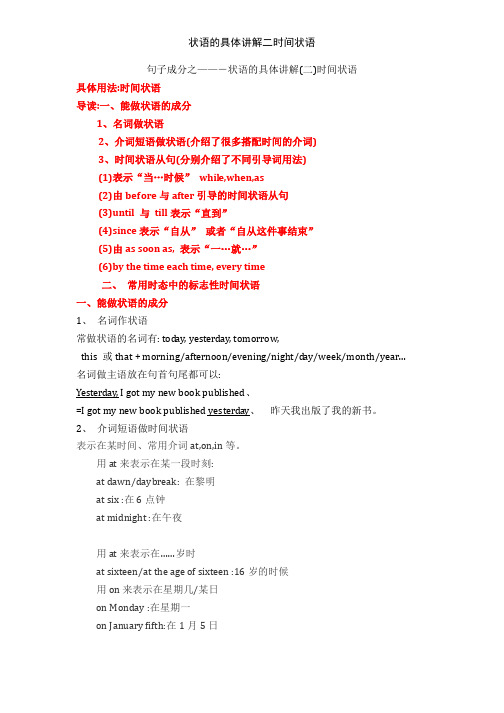
句子成分之——-状语的具体讲解(二)时间状语具体用法:时间状语导读:一、能做状语的成分1、名词做状语2、介词短语做状语(介绍了很多搭配时间的介词)3、时间状语从句(分别介绍了不同引导词用法)(1)表示“当…时候”while,when,as(2)由before与after引导的时间状语从句(3)until 与till表示“直到”(4)since表示“自从”或者“自从这件事结束”(5)由as soon as, 表示“一…就…”(6)by the time each time, every time二、常用时态中的标志性时间状语一、能做状语的成分1、名词作状语常做状语的名词有: today, yesterday, tomorrow,this 或that + morning/afternoon/evening/night/day/week/month/year…名词做主语放在句首句尾都可以:Yesterday, I got my new book published、=I got my new book published yesterday、昨天我出版了我的新书。
2、介词短语做时间状语表示在某时间、常用介词at,on,in等。
用 at 来表示在某一段时刻:at dawn/daybreak: 在黎明at six :在6点钟at midnight :在午夜用 at 来表示在……岁时at sixteen/at the age of sixteen :16岁的时候用 on 来表示在星期几/某日on Monday :在星期一on January fifth:在1月5日on Christmas Day :在圣诞节那一天也可用at Christmason New Year's Day:在新年那天用in来表示一天中的早中晚,月份,季节或年份in the morning/afternoon/evening在早晨,下午,晚上in January/ February在一月,二月in Spring在春天in 2014在2014年表示期间常用介词during,for,over,within,throughout,from与to等。
英语状语从句讲解
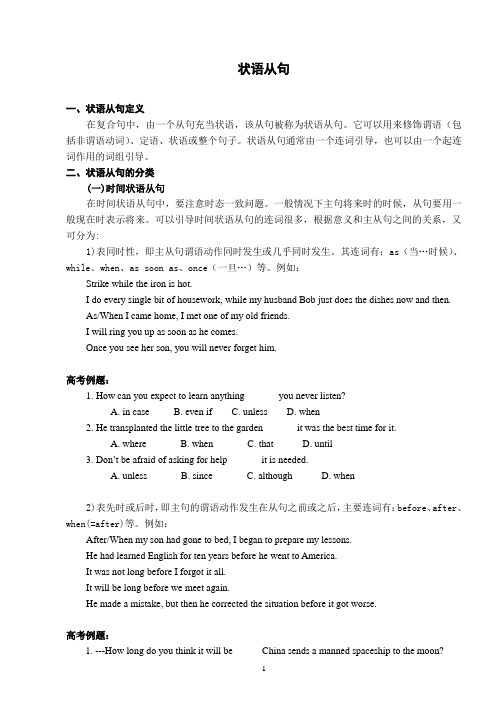
状语从句一、状语从句定义在复合句中,由一个从句充当状语,该从句被称为状语从句。
它可以用来修饰谓语(包括非谓语动词)、定语、状语或整个句子。
状语从句通常由一个连词引导,也可以由一个起连词作用的词组引导。
二、状语从句的分类(一)时间状语从句在时间状语从句中,要注意时态一致问题。
一般情况下主句将来时的时候,从句要用一般现在时表示将来。
可以引导时间状语从句的连词很多,根据意义和主从句之间的关系,又可分为:1)表同时性,即主从句谓语动作同时发生或几乎同时发生。
其连词有:as(当…时候)、while、when、as soon as、once(一旦…)等。
例如:Strike while the iron is hot.I do every single bit of housework, while my husband Bob just does the dishes now and then.As/When I came home, I met one of my old friends.I will ring you up as soon as he comes.Once you see her son, you will never forget him.高考例题:1. How can you expect to learn anything ______ you never listen?A. in caseB. even ifC. unlessD. when2. He transplanted the little tree to the garden ______ it was the best time for it.A. whereB. whenC. thatD. until3. Don’t be afraid of asking for help ______ it is needed.A. unlessB. sinceC. althoughD. when2)表先时或后时,即主句的谓语动作发生在从句之前或之后,主要连词有:before、after、when(=after)等。
时间状语知识点总结
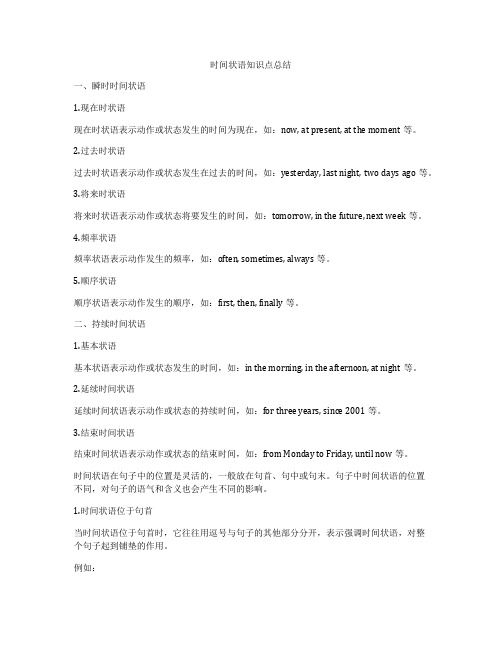
时间状语知识点总结一、瞬时时间状语1.现在时状语现在时状语表示动作或状态发生的时间为现在,如:now, at present, at the moment等。
2.过去时状语过去时状语表示动作或状态发生在过去的时间,如:yesterday, last night, two days ago等。
3.将来时状语将来时状语表示动作或状态将要发生的时间,如:tomorrow, in the future, next week等。
4.频率状语频率状语表示动作发生的频率,如:often, sometimes, always等。
5.顺序状语顺序状语表示动作发生的顺序,如:first, then, finally等。
二、持续时间状语1.基本状语基本状语表示动作或状态发生的时间,如:in the morning, in the afternoon, at night等。
2.延续时间状语延续时间状语表示动作或状态的持续时间,如:for three years, since 2001等。
3.结束时间状语结束时间状语表示动作或状态的结束时间,如:from Monday to Friday, until now等。
时间状语在句子中的位置是灵活的,一般放在句首、句中或句末。
句子中时间状语的位置不同,对句子的语气和含义也会产生不同的影响。
1.时间状语位于句首当时间状语位于句首时,它往往用逗号与句子的其他部分分开,表示强调时间状语,对整个句子起到铺垫的作用。
例如:Tomorrow, I will go to the park with my friends.2.时间状语位于句中当时间状语位于句中时,它与句子的其他部分之间通常用逗号或连接副词连接,表示对动作或状态的限定、说明或补充。
例如:I will go to the park with my friends, tomorrow.3.时间状语位于句末当时间状语位于句末时,它往往用逗号与句子的其他部分分开,表示强调时间状语,对整个句子起到总结的作用。
状语的用法

状语的用法状语是指用来修饰或限定动词、形容词、副词或全句的成分。
它可以提供关于时间、地点、方式、原因、条件等方面的信息,使得句子更加具体和丰富。
本文将介绍状语的定义、分类和用法,并给出一些例子来帮助读者更好地理解。
一、状语的定义状语(Adverbial)是指在句子中修饰动词、形容词、副词或全句的成分。
它可以提供关于时间、地点、方式、原因等方面的信息,起到进一步说明和限定的作用。
二、状语的分类根据状语所表达的内容不同,可以将其分为以下几类:1.时间状语:表示动作发生的时间,如”昨天”、“现在”、“明天”。
2.地点状语:表示动作发生的地点,如“在家”、“在学校”。
3.方式状语:表示动作进行或完成时所采取的方式或手段,如“慢慢地”、“用力地”。
4.原因状语:表示动作发生或状态存在的原因,如“因为”、“由于”。
5.条件状语:表示动作发生或状态存在的条件,如“如果”、“除非”。
6.目的状语:表示动作发生的目的或意图,如“为了”、“以便”。
7.结果状语:表示动作发生后所产生的结果,如“结果”、“以至于”。
8.程度状语:表示动作或状态的程度,如“非常”、“很”。
9.比较状语:表示与其他事物进行比较,如“比…更…”、“像…一样”。
10.伴随状语:表示动作进行时的伴随情况,如“和…一起”、“跟…在一起”。
三、状语的用法1. 在句首或句末状语可以放在句首或句末。
当状语放在句首时,需要用逗号与句子主体分开;当状语放在句末时,则不需要使用任何标点符号。
例如:•昨天,我去了图书馆。
•我去了图书馆昨天。
2. 在动词、形容词、副词前面通常情况下,状语位于被修饰成分之前。
例如:•我慢慢地走到了学校。
•这个问题非常困难。
3. 在整个句子前面有些时候,状语会放在整个句子前面,起到整体修饰的作用。
例如:•为了提高成绩,他每天都很努力学习。
4. 多个状语的顺序多个状语可以同时出现在句子中,它们的顺序通常是:时间、地点、方式、原因、条件、目的、结果、程度等。
时间状语从句知识点讲解
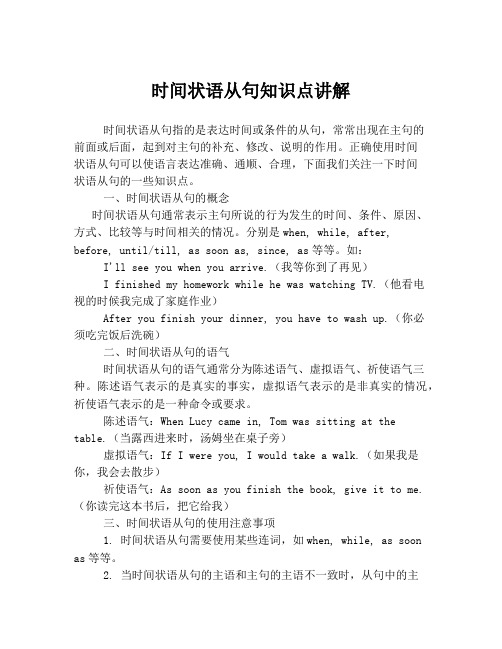
时间状语从句知识点讲解时间状语从句指的是表达时间或条件的从句,常常出现在主句的前面或后面,起到对主句的补充、修改、说明的作用。
正确使用时间状语从句可以使语言表达准确、通顺、合理,下面我们关注一下时间状语从句的一些知识点。
一、时间状语从句的概念时间状语从句通常表示主句所说的行为发生的时间、条件、原因、方式、比较等与时间相关的情况。
分别是when, while, after, before, until/till, as soon as, since, as等等。
如:I'll see you when you arrive.(我等你到了再见)I finished my homework while he was watching TV.(他看电视的时候我完成了家庭作业)After you finish your dinner, you have to wash up.(你必须吃完饭后洗碗)二、时间状语从句的语气时间状语从句的语气通常分为陈述语气、虚拟语气、祈使语气三种。
陈述语气表示的是真实的事实,虚拟语气表示的是非真实的情况,祈使语气表示的是一种命令或要求。
陈述语气:When Lucy came in, Tom was sitting at the table.(当露西进来时,汤姆坐在桌子旁)虚拟语气:If I were you, I would take a walk.(如果我是你,我会去散步)祈使语气:As soon as you finish the book, give it to me.(你读完这本书后,把它给我)三、时间状语从句的使用注意事项1. 时间状语从句需要使用某些连词,如when, while, as soon as等等。
2. 当时间状语从句的主语和主句的主语不一致时,从句中的主语必须与主句中的某个单词有关联。
通常使用指示代词,如this, that, these, those等。
状语从句的时间原因条件等用法详细讲解与注意事项

状语从句的时间原因条件等用法详细讲解与注意事项状语从句的时间、原因、条件等用法详细讲解与注意事项状语从句是在主句中充当状语的从句,它可以描述时间、原因、条件等多种关系。
掌握状语从句的用法对于提高句子的连贯性和表达的准确性非常重要。
在本文中,我们将详细讲解状语从句在时间、原因和条件方面的常见用法,并提供一些注意事项。
一、时间状语从句时间状语从句用来表示主句发生的时间,它可以使用不同的连词来引导,如when(当...时候)、while(当...的时候)、before(在...之前)、after(在...之后)等。
以下是一些常见的时间状语从句的例子:1. When she arrived, we were already eating dinner.(当她到达时,我们已经在吃晚饭了。
)2. He fell asleep while he was watching TV.(他在看电视的时候睡着了。
)3. I will call you before I leave.(在我离开之前,我会给你打电话。
)4. After I finish this project, I will take a vacation.(在我完成这个项目之后,我会去度假。
)注意事项:- 时间状语从句通常位于主句之前或之后,具体位置可根据上下文需要决定。
- 当主句的时态是一般将来时时,时间状语从句的时态可以使用一般现在时或一般过去时。
二、原因状语从句原因状语从句用来说明主句所表达的动作或情况发生的原因,常由because(因为)、since(因为)、as(因为)等连词引导。
以下是一些常见的原因状语从句的例子:1. We canceled the picnic because of the bad weather.(由于天气不好,我们取消了野餐。
)2. Since you don't have a car, I can give you a ride.(由于你没有车,我可以载你。
(完整版)状语从句讲解

状语从句定义:在句中作状语的从句是状语从句,修饰主句中的动词、形容词或副词等。
状语从句由从属连词引导,从属连词在句中不充当句子成分,只起连接作用,状语从句放在句首时,要用逗号,放在句尾时不用。
状语从句主要用来修饰主句或主句的谓语。
一般可分为九大类,分别表示时间、地点、原因、目的、结果、条件、让步、比较和方式。
尽管种类较多,但由于状语从句与汉语结构和用法相似,所以理解和掌握它并不难。
状语从句的关键是要掌握引导不同状语从句的常用连接词和特殊的连接词即考点。
现分别列举如下:一、时间状语从句1.when, while和as的用法(1)when既可引导一个持续动作,也可引导一个短暂性动作.when强调主从句动作的发生有先后。
如:①When he got there, the classroom had been cleaned.他到的时候,教室已打扫过了。
(主句动作发生在从句动作之前)②He went to play football when he finished his homework.做完作业后他就去踢足球了。
(主句的动作发生在从句动作之后)when可作并列连词用,相当于just then,at the time,前一分句多用进行时、be about to或be on the point of doing,表示“正在做..,就在这时发生了另外一件事”或“届时”。
如:①I was reading when he suddenly came in.②I was about to leave when the telephone rang.(2)while强调主句动作发生在从句动作所发生的时间段内,从句的动作必须是延续性动词。
如:①Strike iron while it’s still hot.②Will you please take care of my house while I was away?在这一情况下,从句的动作一定是延续性动词,如果是非延续动词,要用when。
状语从句的时间原因条件等用法详细讲解

状语从句的时间原因条件等用法详细讲解状语从句的时间、原因、条件等用法详细讲解状语从句是指在复合句中作为状语的从句,用来修饰、限制主句中的动作或状态。
在英语中,状语从句主要有时间、原因、条件等多种用法。
下面将详细讲解状语从句在时间、原因、条件等方面的应用。
一、时间状语从句时间状语从句是用来表示主句中的动作或状态发生的时间或顺序关系。
常见的引导时间状语从句的连词有:when(当...时候)、before (在...之前)、after(在...之后)、as soon as(一...就)、while(当...的时候)、until(直到...为止)等。
1. 当...时候当主句中的动作或状态发生时,使用连词when引导时间状语从句。
例如:I will call you when I arrive home.(当我到家的时候,我会给你打电话。
)2. 在...之前表示主句中的动作或状态发生之前,使用连词before引导时间状语从句。
例如:Please finish your homework before you go out to play.(在你出去玩之前,请先完成作业。
)3. 在...之后表示主句中的动作或状态发生之后,使用连词after引导时间状语从句。
例如:She always helps her mother after she finishes her homework.(她总是在完成作业后帮助她的妈妈。
)4. 一...就表示主句中的动作或状态一发生,立刻使用连词as soon as引导时间状语从句。
例如:He went to bed as soon as he got home.(一到家,他就去睡觉了。
)5. 当...的时候表示主句中的动作或状态正在进行时,使用连词while引导时间状语从句。
例如:She was reading a book while her brother was watching TV.(她正在读书,而她的弟弟在看电视。
时间状语与状语从句的区别
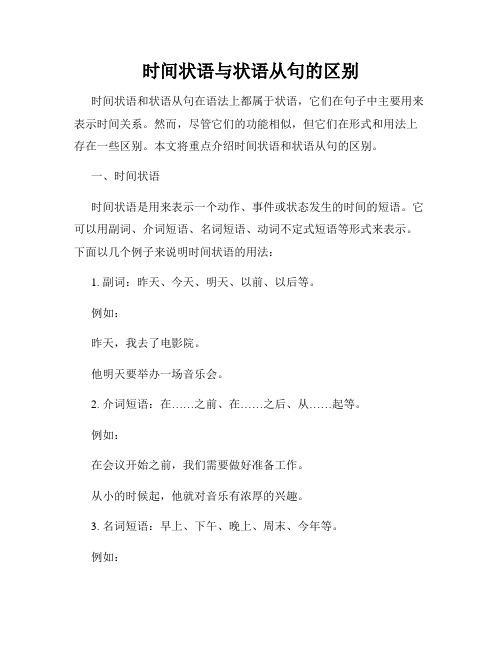
时间状语与状语从句的区别时间状语和状语从句在语法上都属于状语,它们在句子中主要用来表示时间关系。
然而,尽管它们的功能相似,但它们在形式和用法上存在一些区别。
本文将重点介绍时间状语和状语从句的区别。
一、时间状语时间状语是用来表示一个动作、事件或状态发生的时间的短语。
它可以用副词、介词短语、名词短语、动词不定式短语等形式来表示。
下面以几个例子来说明时间状语的用法:1. 副词:昨天、今天、明天、以前、以后等。
例如:昨天,我去了电影院。
他明天要举办一场音乐会。
2. 介词短语:在……之前、在……之后、从……起等。
例如:在会议开始之前,我们需要做好准备工作。
从小的时候起,他就对音乐有浓厚的兴趣。
3. 名词短语:早上、下午、晚上、周末、今年等。
例如:早上,我会去健身房锻炼。
他今年已经去了好几个国家旅行。
二、状语从句状语从句是由一个连词引导的句子,表示一个动作、事件或状态发生的时间,它和主句之间是一种从属关系。
常见的时间状语从句引导词有:when、while、before、after、since、until等。
下面以几个例子来说明状语从句的用法:1. 引导词when:当……时候、在……时间等。
例如:当我看到她的时候,她正在做作业。
在我吃早饭的时候,她已经离开了。
2. 引导词while:在……期间、当……的时候等。
例如:我喜欢听音乐,而他则喜欢看电视。
当我在打扫房间的时候,他正在做饭。
3. 引导词before和after:在……之前、在……之后等。
例如:在他来之前,我已经离开了。
她已经吃完晚饭后,才开始看电视。
三、时间状语与状语从句的区别时间状语和状语从句在形式和用法上存在一些区别。
1. 形式上的区别:时间状语通常是一个短语或者一个词,例如副词、介词短语、名词短语等。
而状语从句是一个完整的句子,由一个引导词和一个主句构成。
2. 位置上的区别:时间状语可以出现在句子的任何位置,可以放在句首、句中或句末。
而状语从句通常放在主句之后,或者主句的中间。
学习中常用的时间状语及用法
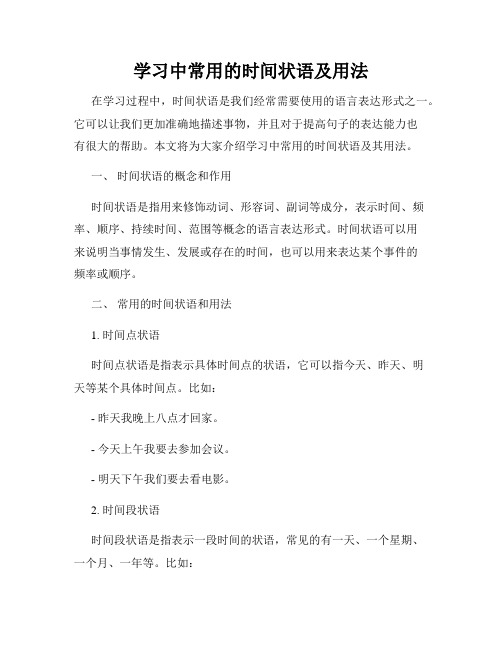
学习中常用的时间状语及用法在学习过程中,时间状语是我们经常需要使用的语言表达形式之一。
它可以让我们更加准确地描述事物,并且对于提高句子的表达能力也有很大的帮助。
本文将为大家介绍学习中常用的时间状语及其用法。
一、时间状语的概念和作用时间状语是指用来修饰动词、形容词、副词等成分,表示时间、频率、顺序、持续时间、范围等概念的语言表达形式。
时间状语可以用来说明当事情发生、发展或存在的时间,也可以用来表达某个事件的频率或顺序。
二、常用的时间状语和用法1. 时间点状语时间点状语是指表示具体时间点的状语,它可以指今天、昨天、明天等某个具体时间点。
比如:- 昨天我晚上八点才回家。
- 今天上午我要去参加会议。
- 明天下午我们要去看电影。
2. 时间段状语时间段状语是指表示一段时间的状语,常见的有一天、一个星期、一个月、一年等。
比如:- 我们学校每天早上八点上课。
- 我要用一个星期的时间完成这个任务。
- 我们公司每个月都会举行一次会议。
3. 频率状语频率状语是指表示动作发生的频率的状语,常见的有每天、经常、偶尔、从不等。
比如:- 他每天都会刷牙洗脸。
- 我们公司经常组织员工培训。
- 她偶尔会来我家玩。
4. 顺序状语顺序状语是指表示事物发生顺序的状语,常见的有首先、其次、最后等。
比如:- 我们首先要完成文案,然后再开始设计。
- 她先拿出手机拍了照,然后才开始吃饭。
- 他先看了一遍,最后才明白这道题的意思。
5. 持续时间状语持续时间状语是指表示动作或状态持续的一段时间的状语,常见的有一段时间、一会儿、一整天等。
比如:- 我们打游戏打了一整晚上。
- 她看书看了一会儿就睡着了。
- 我等了他一段时间后他才到。
三、总结时间状语是我们表达语言时经常使用的一种形式,它可以使句子更加准确地表达时间、频率、顺序、持续时间等概念。
在学习中,掌握常用的时间状语及其用法是提高写作能力的重要部分。
希望本文的介绍可以帮助大家更好地掌握时间状语的用法。
状语的具体讲解(二)时间状语

句子成分之一一-状语的具体讲解(二)时间状语具体用法:时间状语导读:一、能做状语的成分1. 名词做状语2. 介词短语做状语(介绍了很多搭配时间的介词)3. 时间状语从句(分别介绍了不同引导词用法)(1)表示"当…时候” while,when,as(2)由before和after引导的时间状语从句(3)until和till表示“直到”(4)since表示“自从”或者“自从这件事结束”(5)由as soon as, 表示“一…就…”(6)by the time each time, every time二、常用时态中的标志性时间状语一、能做状语的成分1. 名词作状语常做状语的名词有:today, yesterday, tomorrow,this 或that + morning/afternoon/evening/night/day/week/month/year 名词做主语放在句首句尾都可以:Yesterday, I got my new book published.=I got my new book published yesterday. 昨天我岀版了我的新书。
2. 介词短语做时间状语表示在某时间.常用介词at, on, in等。
用at来表示在某一段时刻:at dawn/daybreak :在黎明at six :在6点钟at midni ght :在午夜用at来表示在..... 岁时at sixteen/at the age of sixteen : 16 岁的时候用on来表示在星期几/某日on Mon day :在星期一on January fifth :在1 月5 日on Christmas Day :在圣诞节那一天也可用at Christmason New Year's Day :在新年那天用in来表示一天中的早中晚,月份,季节或年份in the mor nin g/after noon/eve ning 在早晨,下午,晚上in January/ February 在一月,二月in Spring在春天in 2014 在2014 年表示期间常用介词during,for,over,within,throughout,from 和to 等。
- 1、下载文档前请自行甄别文档内容的完整性,平台不提供额外的编辑、内容补充、找答案等附加服务。
- 2、"仅部分预览"的文档,不可在线预览部分如存在完整性等问题,可反馈申请退款(可完整预览的文档不适用该条件!)。
- 3、如文档侵犯您的权益,请联系客服反馈,我们会尽快为您处理(人工客服工作时间:9:00-18:30)。
句子成分之——-状语的具体讲解(二)时间状语具体用法:时间状语导读:一、能做状语的成分1.名词做状语2.介词短语做状语(介绍了很多搭配时间的介词)3.时间状语从句(分别介绍了不同引导词用法)(1)表示“当…时候”while,when,as(2)由before和after引导的时间状语从句(3)until 和till表示“直到”(4)since表示“自从”或者“自从这件事结束”(5)由as soon as, 表示“一…就…”(6)by the time each time, every time二、常用时态中的标志性时间状语一、能做状语的成分1. 名词作状语常做状语的名词有:today, yesterday, tomorrow,this 或that + morning/afternoon/evening/night/day/week/month/year…名词做主语放在句首句尾都可以:Yesterday, I got my new book published.=I got my new book published yesterday.昨天我出版了我的新书。
2. 介词短语做时间状语表示在某时间.常用介词at,on,in等。
用 at 来表示在某一段时刻:at dawn/daybreak:在黎明at six :在6点钟at midnight :在午夜用 at 来表示在……岁时at sixteen/at the age of sixteen :16岁的时候用 on 来表示在星期几/某日on Monday :在星期一on January fifth:在1月5日on Christmas Day :在圣诞节那一天也可用at Christmason New Year's Day:在新年那天用in来表示一天中的早中晚,月份,季节或年份in the morning/afternoon/evening在早晨,下午,晚上in January/February在一月,二月in Spring在春天in 2014在2014年表示期间常用介词during,for,over,within,throughout,from和to等。
during/within 用来表示在一段时间内,区别是during 可以加名词和时间,within后只能加时间。
during the Middle Ages:在中世纪during 1942 :在1942年中during the summer(of that year):在(那一年的)夏季during his childhood :在他童年时期during two years=within two yearsfor用来表示动作或状态持续了一段时间,(要与完成时搭配)for six years :六年之久for two months :有两个月for ever :永远表示其他时间概念的介词有before,after,since,until,till,between,up to等3.时间状语从句引导时间状语从句的连词,常见的有before, after, when while, as, since, till, unil, as soon as 等(1)表示“当…时候”while,when,aswhen引导的从句的谓语动词可以是延续性的动词,可以是瞬时动词。
并且when 有时表示“就在那时”。
例如:When she came in, I stopped eating.她进来时,我停止吃饭。
(瞬时动词) When I lived in the countryside, I used to carry some water for him.当我住在农村时,我常常为他担水。
(延续性的动词)While引导的从句的谓语动作必须是延续性的,并强调主句和从句的动作同时发生(或者相对应)。
并且while有时还可以表示对比。
例如:While my wife was reading the newspaper, I was watching TV. (was reading是延续性的动词,was reading和was watching同时发生) 。
I like playing football while you like playing basketball.我喜欢踢足球,而你喜欢打篮球。
(对比)As表示“一边……一边”,as引导的动作是延续性的动作,一般用于主句和从句动作同时发生;as也可以强调“一先一后。
例如:We always sing as we walk.我们总是边走边唱。
(as表示“一边……一边”)As we were going out, it began to snow.当我们出门时,开始下雪了。
(as强调句中两个动作紧接着先后发生,而不强调开始下雪的特定时间)(2)由before和after引导的时间状语从句before表示“在…之前”,after 表示“在…之后”It will be four days before they come back. 他们要过四天才能回来。
Einstein almost knocked me down before he saw me.爱因斯坦几乎把我撞倒才看到我。
My father had left for Canada just before the letter arrived.我父亲恰好在信到之前去加拿大了。
After you think it over, please let me know what you decide.你仔细考虑过以后,告诉我你是怎样决定的。
After we had finished the work, we went home.完成工作之后,我们回家了。
(3)until 和till表示“直到”主句肯定句中,用延续性动词,until/till后的时间表示相应动作结束的时间:He will wait for his girlfriend until he shows up.他将等他的女朋友直到她出现。
(wait “等待”是延续性动词,动作能够一直持续)主句否定句中,用非延续性动词,until后的时间表示相应动作开始的时间:The letter won’t be sent until you call the postman. 邮件不会被寄出,知道你给邮寄员打电话。
(be sent“被寄出”,非延续性动词,就是一瞬间的动作呢)这两个句型也是可以互换的:I will be here till/until he comes back.我将一直在这里直到他回来。
I won't leave here until he comes back.我将不会离开这里直到他回来。
(4)since表示“自从”或者“自从这件事结束”一般情况下,主句的谓语动词用现在完成时,从句谓语动词用一般过去时。
I have been in Beijing since you left.自从你离开以来,我一直在北京了。
Where have you been since I last saw you? 自上次我和你见面以后,你到哪里去了?在It is +时间+since从句的句型中,主句多用一般现在时。
It is +时间+since A自从A结束后到现在已经多长时间了It is four years since my sister lived in Beijing. 我妹妹不在北京住有四年了。
It is five months since our boss was in Beijing.我们老板离开北京有五个月了。
(5)由as soon as, 表示“一…就…”the minute, the second, the instant, immediately, directly, instantly, 可以放在句首或者句尾。
I will go there directly I have finished my breakfast. 吃完早饭,我立即到那里去。
The moment I heard the news, I hastened to the spot.我一听到消息,马上赶到了出事地点。
As soon as I reach Canada, I will ring you up. 我一到加拿大,就给你来电话。
注意:hardly(scarcely, rarely)…when / before, no sooner…than相当于as soon as 之意。
主句用过去完成时,从句用一般过去时。
当hardly, scarcely, rarely和no sooner位于句首时,主句应用倒装语序。
例如:He had no sooner arrived home than he was asked to start on another journey. 他刚到家,就被邀请开始另一旅程。
No sooner had the sun shown itself above the horizon than he got out of bed to commence work.太阳刚从地平线上升起,他就起床劳动去了。
Hardly had I sat down when he stepped in.我刚坐下,他就进来了。
He had hardly fallen asleep when he felt a soft touch on his shoulder.这个阿拉伯人刚要入睡就感到肩膀上被轻轻一触。
(6)由by the time each time, every time引导的时间状语从句。
注意时态的变化:在一般情况下,如果从句的谓语动词用一般过去时,主句的谓语动词用过去完成时;如果从句的谓语动词By the time you came back, I had finished this book.到你回来时,我已经写完这本书了。
Each time he came to Harbin, he would call on me. 他每次来哈尔滨,总是来看我You grow younger every time I see you. 每次遇到你,见你更年轻了。
By the time you come here tomorrow, I will have finished this work. 你明天来这儿的时候,我将已经完成此工作了。
二. 常用时态中的标志性时间状语时间状语一般被当作时态的标志,那么下面提供了在常见时态中标志性时间状语:一般现在时:every…,sometimes,at…,on Sunday等一般过去时:yesterday,last week,an hour ago,the other day,in 1982,just now等一般将来时:next…,tomorrow,in+一段时间,before+时间点等现在完成时:for,since,so far,ever,never,just,yet,till/until,up to now,in past years,always,recently等过去完成时:before,by+过去的时间,until,when,after,once等过去进行时:this morning,the whole morning,all day,yesterday,from nine to ten last evening…when,while等将来进行时:soon,tomorrow,this evening,on Sunday,by this time,tomorrow,in two days,tomorrow evening。
